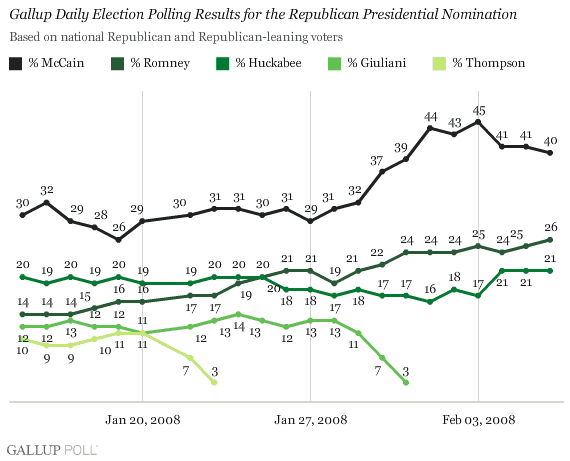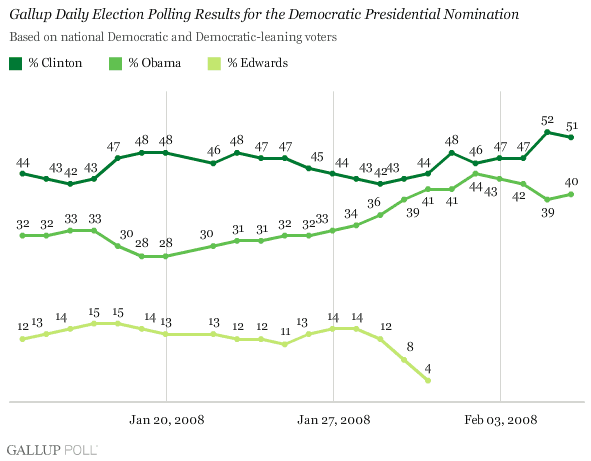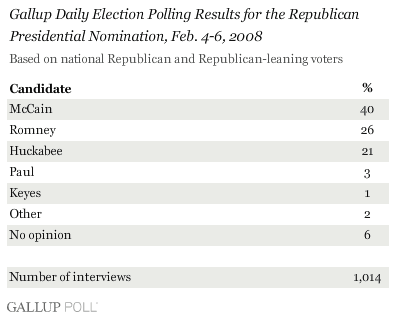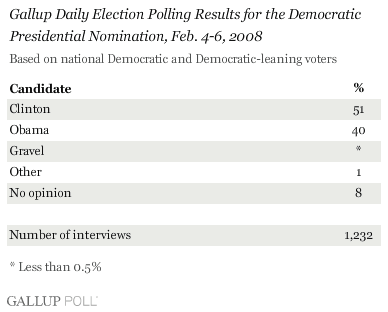PRINCETON, NJ -- Mitt Romney exits the GOP campaign for the presidential nomination closer to John McCain in Gallup Poll Daily tracking than he has been recently. In the tracking data from Feb. 4-6 (which includes the first night of post-Super Tuesday interviewing), front-runner McCain is 14 points ahead of Romney, 40% to 26%, in contrast to a 20-point lead for McCain six days ago. Romney is 5 points ahead of third-place Mike Huckabee. McCain's strength among Republicans crested at 45% in the average for Feb. 1-3, and has now dropped slightly, just as Romney (perhaps ironically) has reached the highest three-day average total since Gallup tracking began on Jan. 3.
Analysis of nightly interviewing conducted on Wednesday, after a day of reports and analysis of Super Tuesday voting results, shows that Romney remained relatively strong, with Huckabee dropping slightly.

Romney's departure leaves just two viable GOP candidates standing: McCain and Huckabee. It is unclear where Romney's vote will go. There has been much discussion lately of the distaste conservative Republicans have for McCain, and according to exit polls, Romney got a greater share of the conservative vote on Super Tuesday than McCain did. Some of Romney's vote could therefore go to Huckabee, but it would represent a significant shift in a two-man race if Huckabee comes close to being competitive with McCain among Republicans. In Thursday's Gallup tracking average -- which includes Romney -- McCain has about twice the vote total of Huckabee.
On the Democratic side, the race is still very much an ongoing battle between the two front-runners, Hillary Clinton and Barack Obama. Nearly three weeks ago, after Clinton won the New Hampshire primary, she had climbed to a 20-point lead over Obama. Then, Obama came charging back until in Gallup's daily tracking interviewing conducted Jan. 31-Feb. 2, he was only 2 points behind Clinton, essentially a tie. But on Sunday and Monday before Super Tuesday voting, Clinton stopped Obama's momentum, and began to climb ahead again. Even on Tuesday, before the results of Super Tuesday were known, Clinton remained ahead.
Thursday's three-day rolling average is the first that includes any post-Super Tuesday interviewing. A look at Wednesday night's results suggests that while Clinton maintains an advantage among Democratic voters, it is much smaller than it had been in recent days. Thus, the overall three-day rolling average -- including Monday, Tuesday, and Wednesday interviewing -- shows a smaller Clinton advantage, 51% to 40%.

From a broad perspective, there have been two periods this year in which Obama has narrowed Clinton's lead among Democrats to a virtual tie, only to fall back each time. The first came after his win in Iowa. In Gallup's Jan 4-6 average, Obama was just three points behind Clinton. Clinton moved back ahead after her unexpected win in New Hampshire, to a lead as large as 20 points over Obama. Then, as noted, Obama began closing the gap until he was only 2 points behind Clinton the weekend before Super Tuesday. Once again, Clinton moved back ahead. Unlike what happened in mid-January, however, it appears Clinton will not expand her lead further, but that the race may tighten again, perhaps in response to news accounts of the Super Tuesday results.
Democratic primary voting continues this weekend in Louisiana and Maine, along with caucuses in Washington and Nebraska. Next Tuesday brings the so-called "Potomac primary" involving Virginia, Maryland, and the District of Columbia. Clinton campaign officials are already defusing expectations by arguing that Obama will be favored to win the caucuses and is favorably positioned in the states holding primaries for the rest of February. If that prophecy comes true, the resulting publicity may push Obama up again in the national tracking.
At this point, especially with Super Tuesday past, Gallup's Daily tracking is measuring the sentiment not of potential voters, but of the broad pool of Republican and Democratic voters across the land, whether or not they may have the opportunity to vote in a primary or that opportunity is still in front of them. Things change rapidly, of course, and voters who cast their votes a month or more ago in Iowa and New Hampshire may now have different opinions. This tracking helps us gauge the sentiment of the voting public as to its current preferences for the party's standard-bearer, and to pick up changes in the dynamics of the campaign.
The vote opinions of those in Gallup Daily tracking will not, of course, represent the actual vote in various states or in particular combinations of states on Election Day. One reason is that the tracking represents a broad sample of all respondents who say they are at least somewhat likely to vote, removing a small percentage who are unable to vote or not engaged in the campaign to any degree. The "not likely to vote" group is less than 20% in general (among both Republicans and Democrats), meaning that over 80% of American adults are included in the voter figures Gallup reports, making it similar to a typical "registered voter" figure.
Those who track voter turnout in various states that voted on Super Tuesday estimate that actual turnout was around 30%, and varied considerably among states. Thus, a broad sample of over 80% of American adults would not be expected to match the actual voting patterns of the much smaller group that turn out to vote in either party's primary.
There is, in fact, strong evidence in the tracking data from the days prior to Super Tuesday that Obama did significantly better when those who reported the highest likelihood of voting are isolated in the sample. Retrospectively, Gallup analysis can isolate just voters who say they are extremely likely to vote -- about 50% of the sample (this still overestimates actual turnout). The vote preferences of Democrats within that smaller slice for the five days prior to Super Tuesday (and after John Edwards left the race) show that Clinton (45%) and Obama (48%) were basically tied.
Even this is broad, of course, because there is significantly different turnout by state that would not be taken into account by this broad tracking, even if reduced to extremely likely voters. In other words, this deals to a significant degree with different universes -- national adults with a light screen for voters, versus actual voters in more than 20 states.
It is important to note that the trends in the Gallup data show that while the general sentiment for Obama became more positive in the week leading up to the weekend before Super Tuesday, his momentum had stopped by Sunday. Had it continued, Obama might have surpassed Clinton in the actual Super Tuesday vote and might have won more states. -- Frank Newport and Jeff Jones


Methodology: Gallup is interviewing 1,000 U.S. adults nationwide each day during 2008. The results reported here are based on combined data from Feb. 4-6, 2008, including interviews with 1,014 Republican and Republican-leaning voters and 1,232 Democratic and Democratic-leaning voters. For results based on these samples, the maximum margin of sampling error is ±3 percentage points. In addition to sampling error, question wording and practical difficulties in conducting surveys can introduce error or bias into the findings of public opinion polls.
